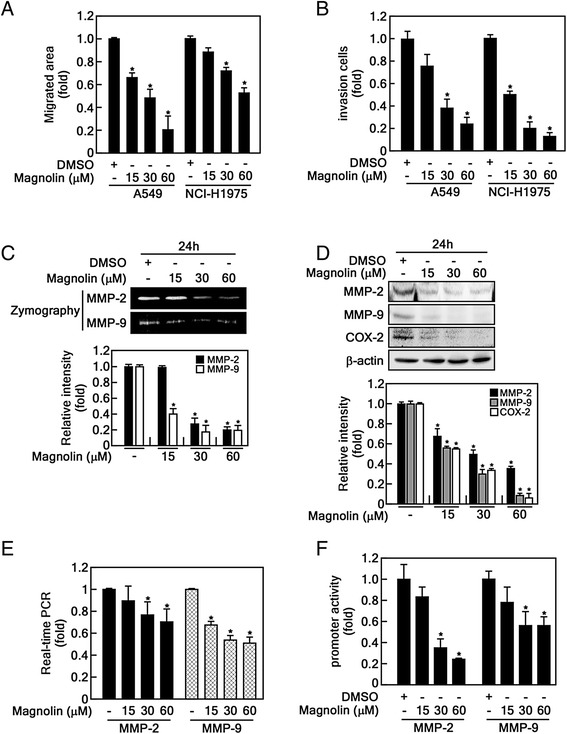Fig. 3.

Magnolin inhibits migration and invasion of human lung cancer cells. a Magnolin inhibits cell migration. A549 or NCI-H1975 cells were seeded into culture-inserts and treated with mitomycin-C. The culture-inserts were removed, the cell migration was measured using the Image J computer software program (v. 1.45), followed by treatment with the indicated doses of magnolin for 24 h. b Magnolin inhibits cancer cell invasion. A549 and NCI-H1975 cells were seeded into the inserts of Boyden chambers and cultured overnight. The cells were treated with the indicated doses of magnolin, and cell invasion was allowed for 24 h. The migrated cells were stained with crystal violet, observed and counted under an inverted microscope. c Magnolin suppresses the activity of MMP-2 and MMP-9. A549 cells (5 × 105) were seeded, cultured, and treated with the indicated doses of magnolin for 24 h. The cultured media was harvested for zymography as described in “Materials and Methods”. d Magnolin reduces the protein levels of MMP-2 and −9. MMP-2 and −9 protein levels from (c) were visualized by Western blotting using the specific antibodies as indicated. β-actin was used as an internal control to verify equal protein loading. e Magnolin inhibits the gene expression of MMP-2 and −9. The MMP-2 and −9 mRNA levels from the cells in (c) were analyzed by real-time PCR as described in “Materials and methods”. f Magnolin suppresses the promoter activities of MMP-2 and −9. A549 cells stably expressing MMP-2 or MMP-9 promoter luciferase reporter plasmid were seeded, cultured, and treated with the indicated doses of magnolin for 24 h. Firefly luciferase activity was measured as described in “Materials and Methods”. a–f Data are presented as the mean ± S.D. of values from triplicate experiments, and statistical significance was determined using the Student’s t-test (*, p < 0.05)
